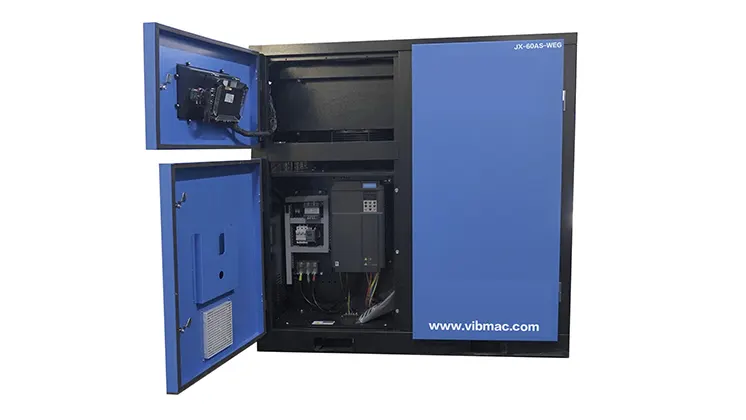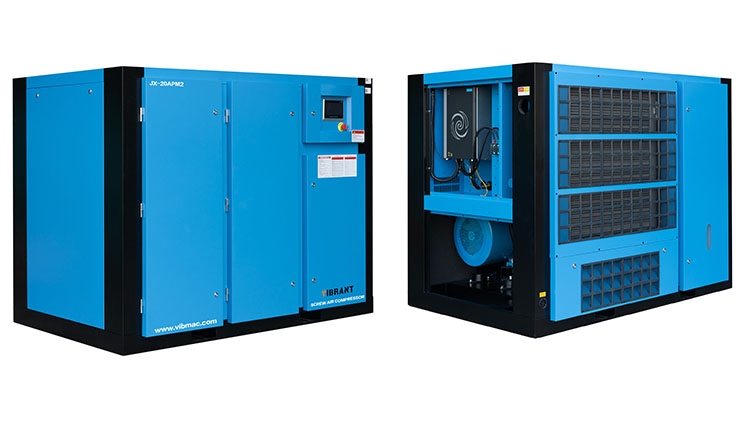
Analysis and Prevention of the Exhaust of Screw Air Compressor Blocked by Ice
2024-03-28
A moving train group found that the total air pressure was low during operation. Through the analysis of the total air data, the Screw Air Compressor operated normally according to the command of the BCU, but the total air pressure continued to drop. According to the on-site investigation, there was an ice blockage in the exhaust pipeline of the air cooler of the main air compressor, which caused the upstream safety valve to start discharging and could not output the required exhaust volume and pressure of the train. The freezing situation was shown in Figure 1.

Under the ambient temperature of -20℃~-10℃, we conducted tests on starting and stopping the main air compressor several times, and the fault reappeared. The air pressure gauge was connected on site for pressure testing, and the pressure value at the safety valve detection point was about 12.5 bar (reaching the safety valve action value), and the pressure value downstream of the cooler was 8 to 8.5 bar.
1. Cause analysis: Screw Air Compressor
1.1 Working principle
The faulty product is an oil-injected screw main air compressor, and its air flow is as follows: the outside air is filtered by the filter and enters the screw main engine to be compressed and mixed with the lubricating oil, and passes through the oil separator for oil and gas separation, and then it is processed by the cooler, the WSDR water separator (with a water filtration efficiency of 90%), the DDR pipeline filter (0.01 ppm), the PDR pipeline filter (0.003 ppm), and the membrane dryer. It enters the main air pipeline after meeting the requirements of compressed air quality level of the train, and the flow of the air pipeline is shown in Figure 2.

1.2 Theoretical analysis
From the thermodynamic theory, the moisture content contained in the air is directly proportional to the temperature and inversely proportional to the pressure. A certain humidity of air compressed temperature and pressure are rising, whether it is saturated and whether there is liquid water precipitation depend on its temperature and pressure rise.
From this, we can rcalculate the wate content m1 under the suction environment of the main air compressor and the saturated water content m2 under the corresponding temperature and pressure after cooling, and by comparing m1 and m2, we can determine whether liquid water is precipitated after the compressed air is cooled.
After on-site investigation and testing, the rate of operation of the main air compressor is about 10%, its ambient temperature: -18 ℃, relative humidity: 80%, cooler outlet temperature: -11.1 ℃, cooler outlet pressure: 9barg. It is calculated by equation (1):
m1=1.26g/m³×80%=1.008g/m³>m2=0.174g/m³ (1)
In summary, the water content of the suction environment of the main air compressor m1 is much larger than the saturated water content of the compressed air at the outlet of the cooler m2, that is, the compressed air at the outlet of the cooler is in a saturated precipitation state, the compressed air in the cooler cooling process has been precipitation of liquid water, due to the temperature is lower than 0 ° C, the liquid water is gradually solidified in the fins inside the cooler and the outlet piping, with the time running, eventually resulting in blockage of the air outlet of the cooler.Due to the ice blockage interception, the downstream total air pressure could not rise to the shutdown pressure of the main air compressor (880kPa), the BCU continued to output the work signal of the main air compressor, and the main air compressor continued to beat the air, which led to the discharge of the safety valve upstream of the cooler, and thus the total air pressure could not be replenished in a timely manner, and with the train running out of air, it ultimately led to an abnormal drop in the total air pressure.
2. Improvement measures
Analyze the structure, working principle and causes of ice blockage failure of oil-injected screw main air compressor, in the case that the operating rate of main Screw Air Compressor can not be changed, reduce the temperature drop of compressed air and achieve the compressed air is above 0 ℃ when saturated with water vapor through certain measures, which can effectively avoid the amount of liquid water precipitation and icing, for this reason, we will optimize in the following 2 aspects.
2.1 Optimization of compressed air cooling air path
(1) Increase the bypass connector at the inlet and outlet of the cooler, and add two new solenoid valves to control the pipeline on and off (NO solenoid valve controls the inlet of the cooler on and off, and NC solenoid valve controls the bypass branch of the cooler on and off), and its power supply is the same as that of the discharge solenoid valve heater, which is supplied by the vehicle side, and is controlled by the 5℃ temperature switch.
(2) When the ambient temperature is greater than 5 ℃, the 2 new solenoid valves are not allowed to power, the normally open solenoid valve (NO) stays open, the normally closed solenoid valve (NC) stays closed, and the compressed air enters the cooler through the NO solenoid valve to carry out conventional cooling.
(3) When the ambient temperature is less than 5 ℃, the two new solenoid valves are energized, the compressed air through the NC solenoid valve directly enters the water separator, reducing the temperature drop of compressed air and controlling the amount of liquid water precipitation.
The optimized air flow and electrical control are shown in Figure 3 and Figure 4.


2.2 Optimization of compressed air post-treatment airway: Screw Air Compressor
Insulation materials were used to wrap the inlets of the WSDR water separator, DDR filter, compressed air piping and membrane dryer to avoid the compressed air from dropping below 0°C in the post-treatment process, as shown in Figure 5.

At the same time, the PDR filter is moved to the inlet of the membrane dryer to intercept the liquid water generated in the pipeline before filtration, the PDR discharge solenoid valve is changed from NO to NC. The control logic is changed from stopping the power off sewage and sewage 2s for every 2min of continuous operation to starting the power on sewage 2s and sewage 2s for every 2min of continuous operation, so as to avoid liquid water entering into the membrane dryer and affecting its service life. The optimized gas flow is shown in Figure 6.

3. Improvement effects
In order to verify the effectiveness of the optimization and modification scheme, the main air compressor is simulated to operate under low temperature and low operating rate, and the temperature monitoring is carried out at various points of the gas circuit, including: T1 at the front end of the cooler, T2 at the front end of the WSDR water separator, T3 at the back end of the WSDR water separator, and T4 at the front end of the membrane dryer, and the specific monitoring positions are shown in Figure 7.

The test data was summarized as follows:
(1) The intermittent operation test data of the air compressor is shown in Table 1.

Through the analysis of the above data, only the temperature of the membrane inlet is lower than 0℃ in such extreme working condition like working condition 1, and there is no icing phenomenon if there is no liquid water precipitation under this temperature; the temperature is higher than 0℃ in working conditions 2 to 4, and there is no risk of icing, but the service life of the membrane dryer will be affected if there is too much liquid water precipitation.
(2) For full illustration, the following analyses are computed and analyzed at 100% relative humidity of the inspiratory environment, as shown in Table 2.

Through the above data analysis, the following conclusions can be drawn:
(1) Under the extreme working condition of low temperature (-40℃), the temperature of each measurement point corresponding to the highest water content is higher than the suction water content, i.e., there is no liquid water precipitation before the compressed air enters into the drier, and there is no risk of ice blockage.
(2) At the highest temperature of the bypass cooler (5℃), the compressed air at the outlet of the WSDR water separator is not saturated, and the compressed air in front of the membrane inlet is in a saturated state. As the retrofit program moves the PDR filter to the membrane inlet, it intercepts and filters the liquid water, and will not affect the service life of the drying membrane.
To sum up, the optimized transformation plan can meet the working conditions of low temperature and low operation rate.
4. Subsequent design directions
Most of the cooling fans in the main air compressor cooler are synchronously driven by the compressor drive motor. In order to meet the demand for high temperature environment of the main air compressor, the cooling fan and the cooler are mostly configured according to the highest operating temperature of the required air volume machine cooling area, which leads to the cooling fan is in working condition in any environment. When the ambient temperature is low and the compressor operating rate is low, there will be too much cooling capacity of the radiator, which will lead to the saturation of compressed air and precipitation of water, and there will be the ice blockage of the cooler, which will influence the demand of air for the train.
In view of the problem, the subsequent design of the product can be considered to set the cooler cooling fan as an independent variable frequency motor drive, through the data collection of the sensors set up in the air circuit, and the use of logic algorithms for real-time adjustment of the cooling fan speed, which can not only reduce the risk of ice blockage of the cooler, but also avoid the high temperature alarm faults and lubricant emulsification and so on.
5. Conclusion
Aiming at the problem of exhaust ice blockage of a screw-type main air compressor used in a moving train set in the process of extreme low-temperature and high humidity operation, we carried out targeted optimization and remediation through on-site troubleshooting and theoretical analysis of the causes, and after remediation, the existing car is well operated. In view of the environmental adaptability of the main air compressor exposed by the failure, combined with the special operating conditions of rail transit, we propose the design direction of intelligent frequency conversion control of the main air compressor for preventing low-temperature ice blockage, high-temperature alarm and lubricant emulsification, so as to further enhance the environmental resistance and usability of the main air compressor used in rail transit vehicles. Read more








